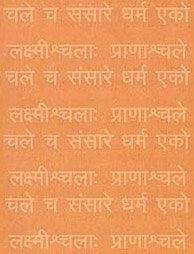Anamaka, Anāmaka: 10 definitions
Introduction:
Anamaka means something in Hinduism, Sanskrit. If you want to know the exact meaning, history, etymology or English translation of this term then check out the descriptions on this page. Add your comment or reference to a book if you want to contribute to this summary article.
In Hinduism
Shaktism (Shakta philosophy)
Source: Google Books: ManthanabhairavatantramAnāmaka (अनामक) (lit. “the nameless”) refers to “(the silence of the) Supreme Brahman”, according to the Manthānabhairavatantra, a vast sprawling work that belongs to a corpus of Tantric texts concerned with the worship of the goddess Kubjikā.—Accordingly, “The New Moon (Amā) dissolves away into the half-measure and the half-measure into the plane of the Nameless [i.e., anāmaka]. O god, the Nameless [i.e., anāmaka] is Kula where the lord is Kuleśvara. I praise that Kula, the essence of Kaula, the venerable ocean of knowledge”.

Shakta (शाक्त, śākta) or Shaktism (śāktism) represents a tradition of Hinduism where the Goddess (Devi) is revered and worshipped. Shakta literature includes a range of scriptures, including various Agamas and Tantras, although its roots may be traced back to the Vedas.
Vedanta (school of philosophy)
Source: ORA: Amanaska (king of all yogas): (Advaita Vedanta)Anāmaka (अनामक) refers to “(that which is) unnamed” and is used to describe Brahma, according to the Māṇḍūkyopaniṣatkārikā 3.35cd-36.—Accordingly, while discussing Brahma (without attributes): “That very [mind, free of thought and restrained,] is fearless Brahma, [which is] the light of gnosis [pervading] everywhere. [It is] unborn, devoid of sleep and dreaming, unnamed (anāmaka), formless, manifested [all] at once and omniscient [This statement] is not figurative in any way”.

Vedanta (वेदान्त, vedānta) refers to a school of orthodox Hindu philosophy (astika), drawing its subject-matter from the Upanishads. There are a number of sub-schools of Vedanta, however all of them expound on the basic teaching of the ultimate reality (brahman) and liberation (moksha) of the individual soul (atman).
Languages of India and abroad
Sanskrit dictionary
Source: DDSA: The practical Sanskrit-English dictionaryAnāmaka (अनामक).—a. [na. ba. svārthe kan] Nameless, infamous.
-kaḥ, -kam = अनामन् (anāman) above.
Source: Cologne Digital Sanskrit Dictionaries: Shabda-Sagara Sanskrit-English DictionaryAnāmaka (अनामक).—mfn.
(-kaḥ-kā-kaṃ) Nameless, nofeless. m.
(-kaḥ) The intercalary menth. n.
(-kaṃ) Piles or hœmorrhoids. E. a bad, nāmaka from nāman a name, with kan aff.
Source: Cologne Digital Sanskrit Dictionaries: Monier-Williams Sanskrit-English Dictionary1) Anāmaka (अनामक):—[=a-nāmaka] [from a-nāman] mfn. nameless, infamous
2) [v.s. ...] m. the intercalary month
3) [v.s. ...] n. piles, haemorrhoids.
Source: Cologne Digital Sanskrit Dictionaries: Goldstücker Sanskrit-English DictionaryAnāmaka (अनामक):—[bahuvrihi compound] I. m. f. n.
(-kaḥ-kā-kam) 1) Nameless.
2) Hav-ing a bad name. Ii. m.
(-kaḥ) An intercalary month. See malamāsa. Iii. n.
(-kam) Piles or hœmorrhoids. E. a priv. or deter. and nāman, samāsānta aff. kap.
Source: Cologne Digital Sanskrit Dictionaries: Yates Sanskrit-English DictionaryAnāmaka (अनामक):—[a-nāmaka] (kaṃ) 1. n. Piles. a. Nameless.
[Sanskrit to German]
Sanskrit, also spelled संस्कृतम् (saṃskṛtam), is an ancient language of India commonly seen as the grandmother of the Indo-European language family (even English!). Closely allied with Prakrit and Pali, Sanskrit is more exhaustive in both grammar and terms and has the most extensive collection of literature in the world, greatly surpassing its sister-languages Greek and Latin.
Kannada-English dictionary
Source: Alar: Kannada-English corpusAnāmaka (ಅನಾಮಕ):—
1) [adjective] having no name; nameless.
2) [adjective] not widely known; not famous.
--- OR ---
Anāmaka (ಅನಾಮಕ):—
1) [noun] the finger nearest the smallest one in the human hand; the ring finger.
2) [noun] a painful swelling of a vein in the region of the anus, often with bleeding; haemorrhoids; piles.
Kannada is a Dravidian language (as opposed to the Indo-European language family) mainly spoken in the southwestern region of India.
See also (Relevant definitions)
Ends with (+3): Agrahyanamaka, Ajanamaka, Anjananamaka, Ardhanamaka, Avanamaka, Damodara bhatta kalopanamaka, Dashanamaka, Ityetanamaka, Jayarama bhatta bhadipanamaka, Keshanamaka, Kritanamaka, Naganamaka, Pattranamaka, Pranamaka, Rama bhatta gahvaropanamaka, Ranganamaka, Ratanamaka, Rathanganamaka, Sanamaka, Upanamaka.
Relevant text
Search found 4 books and stories containing Anamaka, Anāmaka, A-namaka, A-nāmaka; (plurals include: Anamakas, Anāmakas, namakas, nāmakas). You can also click to the full overview containing English textual excerpts. Below are direct links for the most relevant articles:
Cidgaganacandrika (study) (by S. Mahalakshmi)
Verse 230 [Śāstras call Śakti as Avyapadeśya, Anāmaka, Anākhya etc.] < [Chapter 4 - Fourth Vimarśa]
Maha Prajnaparamita Sastra (by Gelongma Karma Migme Chödrön)
Act 1.2: The Buddha smiles a first time with his whole body < [Chapter XIV - Emission of rays]
Consciousness in Gaudapada’s Mandukya-karika (by V. Sujata Raju)
Manas in waking, dream and deep sleep and the realization of No-Mind < [Chapter 5: A Study of Māṇḍūkya Kārikā: Advaita Prakaraṇa]
A History of Indian Philosophy Volume 3 (by Surendranath Dasgupta)
Part 4 - Philosophy of the Jayākhya and other Saṃhitās < [Chapter XVI - The Pañcarātra]